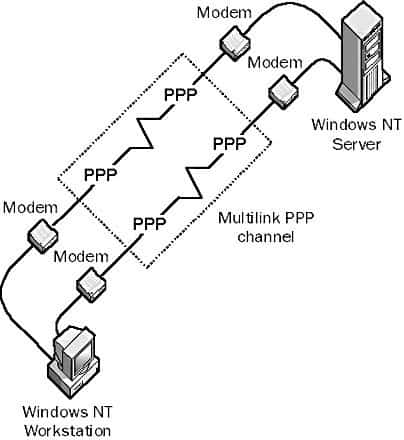Definition of Point-to-Point Protocol (PPP) in Network Encyclopedia.
What is Point-to-Point Protocol (PPP)?
Point-to-Point Protocol is an industry-standard data-link layer protocol for wide area network (WAN) transmission that was developed in the early 1990s. Point-to-Point Protocol (PPP) allows Remote Access Service (RAS) products and devices from different vendors to interoperate for WAN communication.

How It Works
PPP supports the transmission of network packets over a serial point-to-point link by specifying framing mechanisms for encapsulating network protocols such as Internet Protocol (IP), Internetwork Packet Exchange (IPX), or NetBEUI into PPP frames.
PPP encapsulation is based on the High-level Data Link Control (HDLC) derived from the mainframe environment. These PPP frames can be transmitted over serial transmission lines such as Plain Old Telephone Service (POTS), Integrated Services Digital Network (ISDN), and packet-switched networks such as X.25.
PPP includes an extensible Link Control Protocol (LCP) for establishing, tearing down, and testing data-link WAN connections, as well as a number of Network Control Protocols (NCPs) for establishing and configuring network communication using each network protocol. PPP also supports a number of authentication schemes, such as Password Authentication Protocol (PAP) and Challenge Handshake Authentication Protocol (CHAP).
A typical dial-up session using PPP is completely automated and requires no real-time user input. It has four stages:
- Link establishment: PPP uses LCP to establish and maintain a PPP link over a serial transmission line. LCP frames are sent over the data link to test its integrity and establish the link.
- User authentication: PPP uses one of several authentication protocols, including PAP, CHAP, and Microsoft Challenge Handshake Authentication Protocol (MS-CHAP).
- Callback: PPP Callback Control (Microsoft’s implementation of PPP) uses Callback Control Protocol (CBCP) if it is configured.
- Configuration: NCPs are used to establish network connections, perform compression and encryption, lease IP addresses using Dynamic Host Configuration Protocol (DHCP), and so on. NCP frames are sent over the link to establish a network connection between the PPP server and the remote PPP client.
Point-to-Point Protocol vs SLIP
PPP is superior to the older Serial Line Internet Protocol (SLIP) in that it offers error correction and dynamic negotiation without user intervention, supports multiple network protocols simultaneously, and is faster. PPP is the basis for the Point-to-Point Tunneling Protocol (PPTP) and the Layer 2 Tunneling Protocol (L2TP), which can be used to create virtual private networks (VPNs).
PPP is supported by Microsoft Windows 2000, Windows NT, Windows 95, and Windows 98 and is the default setting for Network and Dial-up Connections, RAS, and connectivity to the Internet.
Point-to-Point Protocol troubleshooting
If you can connect to a remote PPP server but can’t ping the remote server, try turning off IP header compression. Windows 98 also allows you to record all PPP communication in a ppplog.txt log file for troubleshooting purposes.
Open the property sheet of your dial-up networking icon, select the Server Types tab, and select the Record A Log File For This Connection option.
IETF standards
PPP is defined in RFC 1661 (The Point-to-Point Protocol, July 1994). RFC 1547 (Requirements for an Internet Standard Point-to-Point Protocol, December 1993) provides historical information about the need for PPP and its development. A series of related RFCs have been written to define how a variety of network control protocols-including TCP/IP, DECnet, AppleTalk, IPX, and others-work with PPP.